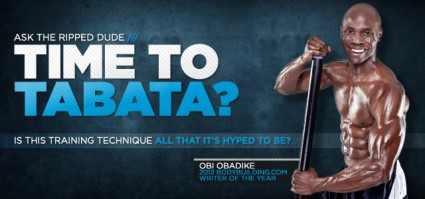Tabata This
Tabata That
Tabata Here
Tabata There
Tabata Everywhere
 From Tony Gentilcore
From Tony Gentilcore
“Tabata Training” Has Become THE Thing of the Minute…..
Classess, workouts, even certifications
So what is Tabata?
The generally accepted definition:
“Eight rounds of ultra-high-intensity exercises in a specific 20-seconds-on, 10-seconds-off interval.”
That means all out for 20 seconds, rest and go at it again for four minutes straight.
That’s REALLY hard.
But it’s not magic, it’s just interval training.
Think about it….
Why eight and not nine rounds? Or 16 or 100?
Why are people doing 30 minute Tabata classes when the study was 4 minutes of intervals?
Cause you Got This Sh@t Wrong Broseph.
Enter Izumi Tabata, he did this study:
“this study showed that moderate-intensity aerobic training that improves the maximal aerobic power does not change anaerobic capacity and that adequate high-intensity intermittent training may improve both anaerobic and aerobic energy supplying systems significantly, probably through imposing intensive stimuli on both systems.” – Tabata et.al
So everybody was all like,
“We can get fit in only 8 minutes and all we have to do is these intervals for 20 seconds on, 10 seconds off?”
And the fitness industry was all like…
“HELL YEAH!”
Except they left this part out:
You need to work at 170% of Vo2 Max for the 8 intervals.
170% of Vo2 Max
I’m gonna make a guess:
You’ve NEVER been close to that number for this amount of time and quite possibly NEVER at all.
They used a stationary bike in the study for that reason……once things get REALLY hairy and you’re form starts to fall into sh@t realm you can continue to pedal your azz off and not get jacked-up.
You ain’t doing that with pushups, jumping jacks, burpees, or whatever….
Ohhh, and they used ELITE level (national level, Olympic hopeful) speed skaters.
 Stole this pic from Reuters.com
Stole this pic from Reuters.com
So I’m guessing they had some training in being totally fucking miserable uncomfortable while maintaining power output (they train they’re whole lives for it) and some pretty strong legs, considering you skate……..on the legs.
Here’s What You Need To Know:
There’s no magic in 8 rounds of 20 seconds on 10 seconds off.
That’s jut the protocol that resulted in the best outcomes in the study (for the group studied), and they used 8 rounds because they athletes (subjects) physically couldn’t continue to produce 170% of Vo2 Max for any more intervals consistently.
“Tabata”
It’s really just incredibly hard interval training…which is fine, and probably good for you in small doses if you’re in really good shape already.
If not, an all out 2:1 work to rest ratio of all out exertion probably isn’t the best protocol for two reasons:
- Those of you that are intermediates will break technique and then break down when the massive fatigue sets in.
- Those of you who are beginners will be working at a terribly low work rate once you’re fatigued and can’t even begin to recover, like after the first or second interval.
So basically you’re probably either setting yourself up for an injury or just doing near lactate/ ventilitory threshold aerobic training where you’re not really doing much anaerobically.
That however doesn’t mean you can’t or shouldn’t do interval training, you should, just pick a more appropriate work to rest ratio.
For most all out interval training I like some of these ratios (work to rest):
- 10’s/ 50’s (Easiest)
- 10’s/ 30’s (Hard)
- 10’s/ 20’s (REALLY HARD, like OMG, I’m gonna die)
- 5’s / 30’s (Easiest)
- 5’s/ 20s (Hard)
- 5’s/ 15’s (REALLY HARD)
Keep in mind that all of these are assuming you’re working ALL OUT when you’re working.
Here’s a general look into how I would progress interval work:
|
Week |
Work |
Rest |
Rounds |
|
1 |
5’s |
30’s |
6 |
|
2 |
5’s |
30’s |
8 |
|
3 |
5’s |
20’s |
8 |
|
4 |
5’s |
20’s |
10 |
|
5 |
10’s |
40’s |
5 |
|
6 |
10’s |
40’s |
6 |
|
7 |
10’s |
30’s |
6 |
|
8 |
10’s |
30’s |
7 |
This isn’t necessarily, or how it ever goes in reality, but it gives you an idea of how I would ramp up interval work over time.
Don’t just start adding time and rounds, you’ll puke, lose your work rate (power output) as you fatigue.
Truth is:
This is still fairly random, and to a large extent, I’m still guessing as to what’s going on with the client because I HAVE NO CLUE what’s going on with their heart rate.
The BEST way to do interval work is to decide on what qualities you’re trying to emphasize and use a heart rate monitor to make sure you’re getting the best training response possible and working within that heart rates zone the entire time.
But you’re not going to get many people who want to wear a heart rate monitor and set it up for heart rate zone training before each session.
Just a fact…
So you’re best bet as a trainer or meathead is to figure out what you’re doing the intervals for, and as long as they serve that purpose go at it.
And yes, sometimes that purpose is just to create a giant metabolic debt, get tired as all F@*K and burn some fat off and that’s cool, probably one of the best uses for interval training.
But if it’s for sports or a specific conditioning purpose know what the hell you’re doing and why you’re doing it and respect intensity and rest intervals.

From EliteTrack.com (you should go to this site if you’re into sport training)
Some approved interval modalities:
- Bike
- Sprints
- Hill Sprints
- Battle Ropes
- Sled Push/ Prowler
- Jump Rope (speed rope)
Interval Training (for performance) Done Right by Joel Jamieson.
Nothing wrong with interval work when applied correctly it’s incredibly effective.
Just realize that “Tabata Training” isn’t some magic bullet….it’s just a different work to rest ratio.
*In the original study the subjects also did one steady state workout per week and Lyle McDonald has an awesome review of the study and the ridiculous extrapolations that have been made from it here.




[…] The Tabata Myth: It's Just Interval Training, Not Magic | Roy … […]